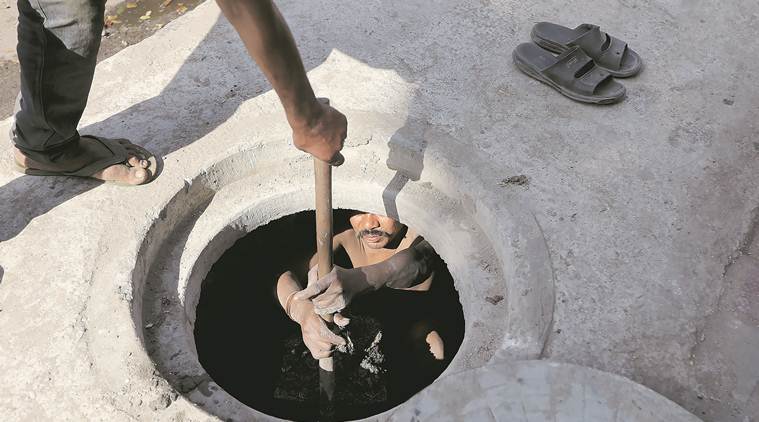
In November last year, three men from Bihar entered a drain in Varanasi. They were promised Rs 5,000 each, quick income in time for their visit home for Chhath Puja. Within the hour, two of them fainted and died from the noxious gases. Their cousin, who escaped with a broken leg, told me that they were daily wagers who worked only on construction sites. They were not equipped to enter drains.
But on that day, they were rounded up and promised more money to break a concrete wall inside a large drain that would divert sewage towards the Dinapur Sewage Treatment Plant (STP). The work was part of an Rs 34-crore sewage network, contracted locally under the National Mission for Clean Ganga (NMCG). But no safety equipment was provided to any of them. Two days later, Prime Minister Narendra Modi flew to Varanasi to inaugurate the STP at Dinapur as part of his government’s efforts to clean the Ganga. The men’s names found no mention in the FIR filed four days after the incident.
On April 26, when Modi filed his nomination to contest once again from Varanasi in the ongoing general elections, he told an Aaj Tak reporter that “water should also be a festival”. “In the past, water bodies were worshipped. Had these left liberals treated (the) Ganga like mother, nobody would have polluted the river,” he said. “Indians considered the Ganga to be so holy that it would wash sins. Throwing trash into the Ganga should be stopped. Sewage should not flow into the Ganga. I have focussed on that, the results are there to see.”
But what about all those people who might think of the Ganga as their mother? What about their source of livelihood for that hour, day, week, month, year, or even lifetime? For those men from Bihar, tasked to smash a wall inside a drain, it was wages that would pay for a child’s tuition, a parent’s ailment. This is the case for several other men and women who live and work along a river that flows over 2,200 kms across five states. They serve as the frontline staff who carry out the dirty work during festivals, like the Kumbh Mela, so that politicians can later take credit in campaign speeches.
Take Kanpur, for example. Six writ petitions have been filed over the last nine years by a supervisor, an operator, a scrubber operator, a safai karamchari, and two pump operators at the Common Effluent Treatment Plant (CETP) in Jajmau.
These petitions have demanded regularisation of work, better pay, health benefits, and provident fund options for the 200-odd men who manage a plant that treats tannery waste laced with chromium in the most polluted city along the river. The men are sick, and have been getting sicker over the last two decades — skin disorders, lung problems, heart conditions. They showed me the pills they take, the prescriptions they carry in their shirt pockets, the contaminated bore-well water they cannot drink. Nobody eats vegetables grown in Jajmau.
Many of them have worked at the CETP for nearly two decades and speak fondly about a river on the banks of which they grew up. Eighty per cent of the funds (nearly Rs 20,000 crore) sanctioned under the NMCG, till six months ago, had gone towards putting in place sewage infrastructure — an integral part of which is the labour that runs the show. They bear the brunt to make the Ganga safe and clean for those who have the privilege to worship the river as their mother.
If the goal is to have a cleaner river, the objective should be to make more nuanced interventions. The cleanliness of the river on the ground is driven by engineering. The onsite senior engineers at STPs, overwhelmingly men from mechanical and electrical backgrounds, think of cleanliness “within norms”. It narrows down to checking boxes after parameters have been met.
This does not consider the health of the worker, the health of the river from an environmental standpoint or ensuring that the processes in place work smoothly. The responsibility for cleaning the river instead seems to be cordoned off, contained within the compound walls of the executing agencies across the cities that I visited.
The official version of how the system works is straightforward: Intercepting polluting drains, diverting and capturing it at a particular place, pumping it towards an STP, and treating the sewage to reduce the level of contaminants before pouring it back into the river. It is a policy that works perfectly in theory, but encounters hiccups in sprawling cities which have a chronic plastic pollution problem and where numerous houses are not connected to the sewerage network.
An interaction I witnessed in Kanpur between two officials, one from the Jal Nigam and another from the Kanpur Nagar Nigam, arguing over who is responsible for keeping solid waste out of the drain, was telling. The officials disagreed on how to ensure that people don’t dump waste into the drain.
Meanwhile, behind them, sitting on a low wall of the Sisamau Nallah was Barkun Nisha. “All the city waste flows into the drain,” she told me. “People throw mattresses and anything else they want to dispose off. In the monsoon, we wade through sewage in our homes because the drain overflows into our homes.”
Behind her, a Nagar Nigam truck dips a fork claw into the drain and excavates solid waste and dumps it in the truck. There was no clear idea as to where the waste will be taken. Residents gather to watch — children are pushed back for their safety. Someone shared a story of a child having fallen into the drain 30 years ago, and found floating on the Ganga.